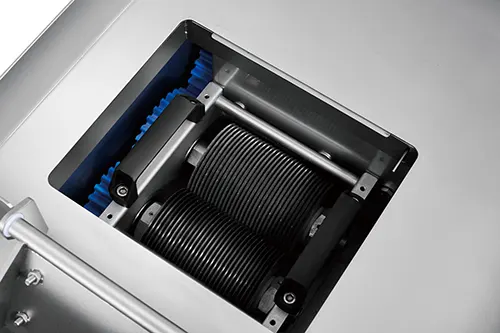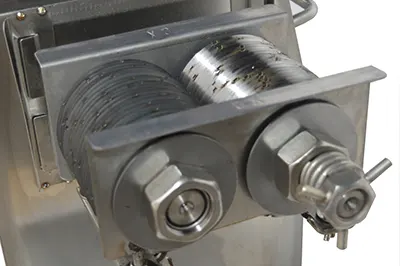Are you in the market for a commercial meat cutting machine but don’t know where to start? Look no further than this ultimate guide to finding the perfect machine that suits all your needs. Whether you own a restaurant, butcher shop, or even a catering business, investing in a high-quality meat cutting machine is essential for efficiency and productivity.
In this comprehensive guide, we will walk you through the key factors to consider when choosing a commercial meat cutting machine. From the type of machine that best fits your requirements to the various features and blades available, we’ve got you covered. We will also discuss the importance of durability and ease of maintenance, as well as provide tips on how to keep your machine in top shape for longer.
Finding the right commercial meat cutting machine can be a daunting task, but with our expert advice, you can make an informed decision. So, grab a cup of coffee and let’s dive into the world of meat cutting machines to find the perfect one for your business.
Keywords:
Commercial meat cutting machine, ultimate guide, finding, perfect, machine
Brand Voice: Professional, informative
Table of Contents
Factors to consider when choosing a commercial meat cutting machine
When it comes to finding the perfect commercial meat cutting machine, there are several important factors to consider. The first and foremost factor is the type of meat you will be cutting. Different machines are designed for specific types of meat, such as beef, poultry, or fish. It’s crucial to choose a machine that can handle the type of meat you’ll be working with on a regular basis.
Another essential factor to consider is the volume of meat you need to cut. If you run a high-volume operation, such as a large restaurant or a busy butcher shop, you’ll need a machine with a higher capacity and faster cutting speed. On the other hand, if you have a smaller business or a more specialized menu, a lower-capacity machine may be sufficient.
The size of the machine is also an important consideration. You’ll need to ensure that the machine fits comfortably in your workspace and doesn’t take up too much valuable real estate. Additionally, the weight of the machine should be taken into account, as you’ll need to ensure that the machine can be safely installed and moved around as needed.
Finally, the budget you have set aside for the purchase of a commercial meat cutting machine is a crucial factor. Prices can vary significantly depending on the brand, features, and quality of the machine. It’s important to research and compare different options to find the best value for your money, while still ensuring that the machine meets your specific needs.

Features to look for in a commercial meat cutting machine
When it comes to commercial meat cutting machines, there are a variety of features to consider. One of the most important features is the blade type and size. Different blades are designed for different types of meat and can vary in thickness, length, and sharpness. It’s important to choose a blade that can handle the specific types of meat you’ll be cutting.
Another important feature is the machine’s speed and efficiency. Look for a machine that can cut meat quickly and accurately, reducing waste and increasing productivity. Some machines even come with automatic slicing capabilities, which can further streamline the cutting process.
Ease of use and maintenance is also a crucial factor. Look for a machine that is intuitive and easy to operate, with clear instructions and user-friendly controls. Additionally, consider the machine’s maintenance requirements, such as how often the blade needs to be sharpened or replaced, and how easy it is to clean and maintain.
Safety is another critical feature to consider. Look for a machine that comes with built-in safety features, such as blade guards, emergency stop buttons, and automatic shut-off mechanisms. These features can help prevent accidents and ensure the safety of your employees.
Finally, consider the machine’s overall durability and reliability. Look for a machine that is built to last, with a sturdy construction and high-quality components. This will ensure that your investment in a commercial meat cutting machine will pay off in the long run, as you won’t have to replace it as often.

Best practices for using a commercial meat cutting machine
Using a commercial meat cutting machine correctly and safely is essential for maintaining productivity, efficiency, and safety in your business. One of the most important best practices is to ensure that all employees who will be operating the machine are properly trained and certified. This includes training on the machine’s specific features, safety protocols, and maintenance procedures.
Another best practice is to establish and follow a regular maintenance schedule for your commercial meat cutting machine. This includes regularly sharpening the blade, cleaning the machine, and inspecting for any wear or damage. By keeping your machine well-maintained, you can extend its lifespan and ensure that it continues to perform at its best.
When it comes to actually using the machine, it’s important to follow all safety protocols and procedures. This includes wearing the appropriate personal protective equipment (PPE), such as cut-resistant gloves and aprons, and keeping the work area clear of any obstructions or distractions. It’s also important to never attempt to cut frozen or hard-to-cut meats, as this can damage the machine and potentially cause injury.
Another best practice is to properly prepare the meat before cutting. This includes ensuring that the meat is at the appropriate temperature, trimming any excess fat or connective tissue, and cutting the meat into manageable pieces. This can help to ensure that the cutting process is efficient and accurate, reducing waste and maximizing productivity.
Finally, it’s important to keep accurate records of the machine’s usage and maintenance. This can help you to plan for future maintenance and replacement needs, as well as to troubleshoot any issues that may arise. By following these best practices, you can ensure that your commercial meat cutting machine continues to perform at its best and helps to keep your business running smoothly.
Types of commercial meat cutting machines
When it comes to commercial meat cutting machines, there are several different types to choose from, each with its own unique features and capabilities. One of the most common types is the manual meat slicer, which is operated by hand and is ideal for low-volume operations or for cutting specialty meats. These machines are typically less expensive than their automated counterparts, but they require more manual labor and can be slower.
Another type of commercial meat cutting machine is the automatic meat slicer, which uses a motorized blade to cut the meat. These machines are ideal for high-volume operations, as they can cut meat quickly and efficiently with minimal effort from the operator. Automatic meat slicers come in a variety of sizes and capacities, so you can choose one that fits your specific needs.
In addition to slicers, there are also commercial meat grinders, which are used to grind or mince meat. These machines are essential for businesses that produce ground meat products, such as burgers or sausages. Meat grinders come in a range of sizes and power levels, so you can choose one that can handle the volume of meat you need to process.
Another type of commercial meat cutting machine is the band saw, which is used to cut larger pieces of meat into smaller, more manageable cuts. Band saws are particularly useful for cutting through bone or tough connective tissue, making them a popular choice for butcher shops and meat processing facilities. These machines are typically larger and more powerful than other types of meat cutting machines, and they require more space and specialized training to operate safely.
Finally, there are also commercial meat tenderizers, which are used to break down the tough fibers in meat, making it more tender and easier to chew. These machines can be manual or automatic, and they are often used in conjunction with other meat cutting equipment to produce high-quality, tender meat products.
Maintenance and cleaning tips for a commercial meat cutting machine
Proper maintenance and cleaning of your commercial meat cutting machine is essential for ensuring its longevity and optimal performance. One of the most important maintenance tasks is regularly sharpening the blade. Dull blades can not only slow down the cutting process, but they can also increase the risk of accidents and injuries. It’s recommended to sharpen the blade at least once a week, or more frequently if the machine is used heavily.
In addition to sharpening the blade, it’s also important to clean the machine thoroughly after each use. This includes wiping down all surfaces with a sanitizing solution, removing any debris or food particles, and ensuring that the machine is completely dry before storing it. Proper cleaning not only helps to maintain the machine’s hygiene and food safety standards, but it also helps to prevent the buildup of grime and residue that can wear down the machine’s components over time.
Another important maintenance task is to regularly inspect the machine for any signs of wear or damage. This includes checking the blade for any cracks or chips, as well as inspecting the machine’s moving parts for any signs of wear or looseness. If any issues are detected, it’s important to address them promptly to prevent further damage and ensure the machine’s continued safe and reliable operation.
It’s also important to follow the manufacturer’s recommended maintenance schedule for your specific commercial meat cutting machine. This may include tasks such as lubricating moving parts, replacing worn components, or performing more extensive maintenance procedures. By following the manufacturer’s guidance, you can help to ensure that your machine continues to perform at its best and that you get the most value out of your investment.
Finally, it’s important to properly store and transport your commercial meat cutting machine when not in use. This includes storing the machine in a clean, dry, and secure location, and using appropriate lifting and moving equipment when transporting the machine to a new location. By taking these precautions, you can help to protect your investment and ensure that your machine remains in top condition for years to come.
Conclusion and final thoughts
In conclusion, finding the perfect commercial meat cutting machine for your business is a critical decision that requires careful consideration of a variety of factors. From the type of meat you’ll be cutting to the size and capacity of the machine, there are many important elements to weigh before making a purchase.
By taking the time to research and understand the different features and capabilities of commercial meat cutting machines, you can ensure that you make an informed decision that will serve your business well for years to come. Whether you’re looking for a manual meat slicer, an automatic meat grinder, or a specialized band saw, there’s a machine out there that can help you streamline your operations and improve your productivity.
Of course, once you’ve selected the perfect commercial meat cutting machine, it’s important to prioritize proper maintenance and safety protocols to ensure that it continues to perform at its best. By following best practices for cleaning, sharpening, and operating the machine, you can extend its lifespan and protect your investment.
Ultimately, investing in a high-quality commercial meat cutting machine can be a game-changer for your business. By optimizing your meat cutting processes, you can improve efficiency, reduce waste, and better serve your customers. So, take the time to explore your options, do your research, and find the perfect machine to take your business to the next level.


Meat Slicers
14″ Electric Stainless Steel Semi Automatic Meat Slicer Machine 360T
Meat Slicers
12″ Electric Stainless Steel Semi-automatic Meat Slicer 300T
Meat Slicers
10″ Kitchen Tool Electric Semi-automatic Slicer 250T
Meat Slicers
8″ Semi Automatic Meat Slicer 220T
Meat Slicers
13″ High-end Fully Automatic Beef Meat Slicer Machine 320KRS
Meat Slicers
12″ Fully Automatic Meat Slicer Machine 300KRS
Meat Cutter
304 Stainless Steel Meat Cutter Machine QE 500kg/H
Meat Slicers
13″ Table Top Frozen Meat Slicers 320KF
Meat Slicers
12″ Table Top Frozen Meat Slicer 300KF
Meat Slicers
14″ Commercial Automatic Meat Slicer For Sale 360KTS
Meat Slicers
13″ Commercial Automatic Meat Slicer 320KTS
Meat Slicers
12″ Electric Meat Slicer Supplier 300KTS